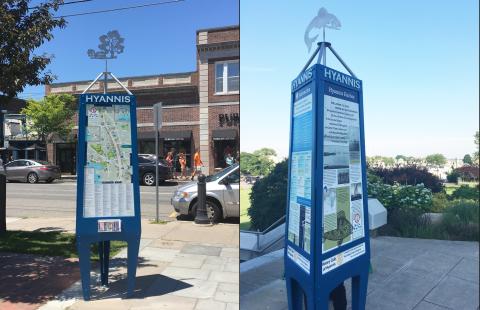What were the specific goals of this creative economy project? Describe the community development challenge or opportunity that your project was designed to address:
The project goals:
1. INFORM and EDUCATE - to connect Main Street with a common navigational language that will educate residents about their village and guide visitors.
2. ECONOMIC - to provide easy orientation and encourage interaction with businesses along the whole street.
3. ORIENTATION - to provide regular identification along our mile long Main Street, to assist in way finding and identity.
4. HEALTH - to give information about relative distances on a newly designed map, aiding in walkability, safety, parking, business promotion. To promote civic pride.
If the goals change over time, please describe how:
They did not change.
Who was involved in this project and what did they do? (be sure to include the partners from outside of the creative sector and how local voices were included):
The project was initiated by The Hyannis BID who connected The Hyannis Rotary and The Design Initiative - both organizations had expressed interest in investing funds and talent into the " Dress Up Downtown" program. The Rotary, who funded the whole project, played a major role with its support, The Design Initiative - a local design firm - brought way-finding and design expertise. The BID was the conduit to local businesses and institutions, critical for feedback. The Town was consistently supportive ( by coordinating al efforts with land use, DPW, etc) of what was a privately funded and installed project. An integral part of the design process was a community meeting were everything from content to color was discussed. Local historians, librarians etc were consulted for all research. Residents were encouraged to contribute content by e-mail as well. This process resulted in some lovely " I did not know that" moments throughout the summer as residents and visitors discovered their town and connected the present with the past.
How does this project relate to a larger community development strategy?
The 7 kiosks are part of an designed system of graphics and signs that can be used to extend the idea along Main St and the Harbor. The system was design as phase 1 of this project. The whole team understood the importance of having a system that to provide visual consistency. Phase 1 also helped establish realistic budgets and identify qualified vendors. in 2019 funding is being sought foradditions to the original 7 kiosks. Having the system allow for future partners to be sure to match the sign type they need with a specific location or content.
Locations were carefully chosen to not only highlight areas that are already central but those zones along the street that are integral to planning.
What projects or places, if any, inspired your approach to this creative economy project?
Inspired by other waterfront towns with story telling way finding along their Main St and harbor: Salem, Newport. Hudson.
